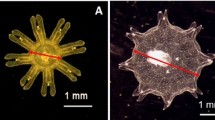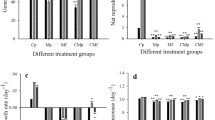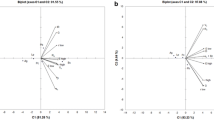Abstract
Five species of tintinnids, Amphorella quadrilineata (Claparède and Lachmann, 1858), Tintinnopsis cf. beroidea Stein (1867), T. cf. acuminata Daday (1887), Eutintinnus pectinis (Kofoid and Campbell, 1929), and Helicostomella subulata (Ehrenberg, 1833), were isolated from Southern California coastal waters and maintained in laboratory cultures which were used to investigate, several aspects of the feeding dynamics and population growth rates of this group of planktonic ciliates. Data are most complete for the latter three species. Both E. pectinis and H. subulata displayed ingestion and growth rates which increased with increasing food concentration until a maximum rate was obtained which then remained essentially constant as food levels increased further. Maximum hourly ingestion was equivalent to approximately 10 to 20% of the body weight of the tintinnids. T. cf. acuminata showed no such maximum ingestion rate, as ingestion rates increased throughout the entire range of food concentrations used. The dependence of growth rate of T. cf. acuminata on food concentration also differed from the other species, being characterized by a broad region of maximum growth at intermediate food levels with reduced growth at both lower and higher food concentrations. Maximum observed growth rates represented doubling times of approximately 12 h for both E. pectinis and T. cf. acuminata and 24 h for H. subulata. The data suggested gross growth efficiencies exceeding 50% over much of the range of food concentrations used. No strong evidence supporting the existence of feeding thresholds or “switching” behavior was collected during these experiments, although apparently selective feeding was observed in one experiment with E. pectinis.
Similar content being viewed by others
Literature Cited
Beers, J.R., F.M.H. Reid and G.L. Stewart: Microplankton of the North Pacific Central Gyre. Population structure and abundance, June, 1973. Int. Revue ges. Hydrobiol. 60, 607–638 (1975)
—, M.R. Stevenson, R.W. Eppley and E.R. Brooks: Plankton populations and upwelling off the coast of Peru, June 1969. Fish. Bull. U.S. 69, 859–876 (1971)
— and G.L. Stewart: Micro-zooplankton in the euphotic zone at five locations across the California Current. J. Fish. Res. Bd Can. 24, 2053–2068 (1967)
——: The ecology of the plankton off La Jolla, California, in the period April through September, 1967. Part VI. Numerical abundance and estimated biomass of microzooplankton. Bull. Scripps Instn Oceanogr. (New Ser.) 17, 67–87 (1970)
——: Micro-zooplankters in the plankton communities of the upper waters of the eastern tropical Pacific. Deep-Sea Res. 18, 861–883 (1971)
Blackbourn, D.J.: The feeding biology of tintinnid Protozoa and some other inshore microzooplankton, 224 pp. Ph.D. Thesis, University of British Columbia 1974
Caperon, J.: Population growth in micro-organisms limited by food supply. Ecology 48, 715–722 (1967)
Corner, E.D.S., R.N. Head and C.C. Kilvington: On the nutrition and metabolism of zooplankton. VIII. The grazing of Biddulphia cells by Calanus helgolandicus. J. mar. biol. Ass. U.K. 52, 847–861 (1972)
———: and L. Pennycuick: On the nutrition and metabolism of zooplankton. X. Quantitative aspects of Calanus helgolandicus feeding as a carnivore. J. mar. biol. Ass. U.K. 56, 345–358 (1976)
Curds, C.R. and A. Cockburn: Studies on the growth and feeding of Tetrahymena pyriformis in axenic and monoxenic culture. J. gen. Microbiol. 54, 343–358 (1968)
——: Continuous monoxenic culture of Tetrahymena puriformis. J. gen. Microbiol. 66, 95–108 (1971)
Eppley, R.W., R.H. Holmes and J.D.H. Strickland: Sinking rates of marine phytoplankton measured with a fluorometer. J. exp. mar. Biol. Ecol. 1, 191–208 (1967)
Fenchel, T.: The ecology of marine microbenthos. III. The reproductive potential of ciliates. Ophelia 5, 123–136 (1968)
—: Intrinsic rate of natural increase: the relationship with body size. Oecologia 14, 317–326 (1974)
Frost, B.W.: Effects of size and concentration of food particles on the feeding behavior of the marine planktonic copepod Calanus pacificus. Limnol. Oceanogr. 17, 805–815 (1972)
—: A threshold feeding behavior in Calanus pacificus. Limnol. Oceanogr. 20, 263–266 (1975)
Gold, K.: Some observations on the biology of Tintinnopsis sp. J. Protozool. 15, 193–194 (1968)
—: Methods for growing Tintinnida in continuous culture. Am. Zool. 13, 203–208 (1973)
Hamilton, R.D. and J.E. Preslan: Observations on the continuous culture of a planktonicphagotrophic protozoan. J. exp. mar. Biol. Ecol. 5, 94–104 (1970)
Heal, O.W.: Quantitative studies on soil amoeba. In: Progress in soil biology, pp 120–126. Ed. by O. Graff and J.E. Satchel. Amsterdam: North Holland Publishing Co. 1967
Hirota, J.: Laboratory culture and metabolism of the planktonic ctenophore, Pleurobrachia bachei A. Agassiz. In: Biological oceanography of the Northern North Pacific Ocean, pp 465–484. Ed. by A.Y. Takenouti et al. Tokyo: Idemitsu Shoten 1972
Johannes, R.E.: Influence of marine Protozoa on nutrient regeneration. Limnol. Oceanogr. 10, 434–442 (1965)
Landry, M.R.: A review of important concepts in the trophic organization of pelagic ecosystems. Helgoländer wiss. Meeresunters. 30, 8–17 (1977)
Marshall, S.M.: Respiration and feeding in copepods. Adv. mar. Biol. 11, 57–120 (1973)
Millin, M.M. and E.R. Brooks: Laboratory culture, growth rate, and feeding behavior of a planktonic marine copepod. Limnol. Oceanogr. 12, 657–666 (1967)
—, E.F. Stewart and F.J. Fuglister: Ingestion by planktonic grazers as a function of concentration of food. Limnol. oceanogr. 20, 259–262 (1975)
Murdoch, W.W. and A. Oaten: Predation and population stability. Adv. ecol. Res. 9, 1–131 (1975)
Nival, P. and S. Nival: Particle retention efficiencies of an herbivorous copepod, Acartia clausi (adult and copepodite states): effects on grazing. Limnol. Oceanogr. 21, 24–38 (1976)
Petipa, T.S., E.V. Pavlova and G.N. Mironov: The food web structure, utilization and transport of energy by trophic levels in the planktonic communities. In: Marine food chains, pp 142–167. Ed. by J.H. Steele. Edinburgh: Oliver & Boyd 1970
Proper, G. and J.C. Garver: Mass culture of the protozoa Colpoda steinii. Biotechnol. Bioengng 8, 287–296 (1966)
Reid, F.M.H., E. Fuglister and J.B. Jordan: The ecology of the plankton off La Jolla, California, in the period April through September, 1967. Part V. Phytoplankton taxonomy and standing crop. Bull. Scripps Instn Oceanogr. (New Ser.) 17, 51–66 (1970)
Reeve, M.R.: Feeding of zooplankton, with special reference to some experiments with Sagitta. Nature, Lond. 201, 211–213 (1964)
Rigler, F.H.: Zooplankton. In: A manual on methods for the assessment of secondary productivity in fresh waters, pp 228–255. Ed. by W.T. Edmondson and G.G. Winberg. Oxford: Blackwell Scientific Publishers 1971. (I.B.P. Handbook No. 17)
Rudzinska, M.A.: The influence of amount of food on the reproduction rate and longevity of a suctorian (Toxophora infusionum). Science, N.Y. 113, 10–11 (1951)
Sharp, J.H.: Improved analysis for “particulate” organic carbon and nitrogen from seawater. Limnol. Oceanogr. 19, 984–989 (1974)
Solomon, M.E.: The natural control of animal populations. J. Anim. Ecol. 18, 1–35 (1949)
Spittler, P.: Feeding experiments with tintinnids. Oikos (Suppl.) 15, 128–132 (1973)
Steele, J.H.: The structure of marine ecosystems, 128 pp. Cambridge, Mass: Harvard University Press 1974
Vitiello, P.: Contribution à l'étude des tintinnides de la baie d'Alger. Pélagos 2, 5–41 (1964)
Zaika, V.Ye. and N.A. Ostrovskaya: Pattern of diurnal variations in microzooplankton abundance in the surface layer of the Mediterranean Sea. Oceanology 12, 725–729 (1972)
Zeuthen, E.: Body size and metabolic rate in the animal kingdom with special regard to the marine microfauna. C.r. Trav. Lab. Carlsberg (Sér. chim.) 26, 17–161 (1947)
Author information
Authors and Affiliations
Additional information
Communicated by M.R. Tripp, Newark
Rights and permissions
About this article
Cite this article
Heinbokel, J.F. Studies on the functional role of tintinnids in the Southern California Bight. I. Grazing and growth rates in laboratory cultures. Mar. Biol. 47, 177–189 (1978). https://doi.org/10.1007/BF00395638
Accepted:
Issue Date:
DOI: https://doi.org/10.1007/BF00395638




